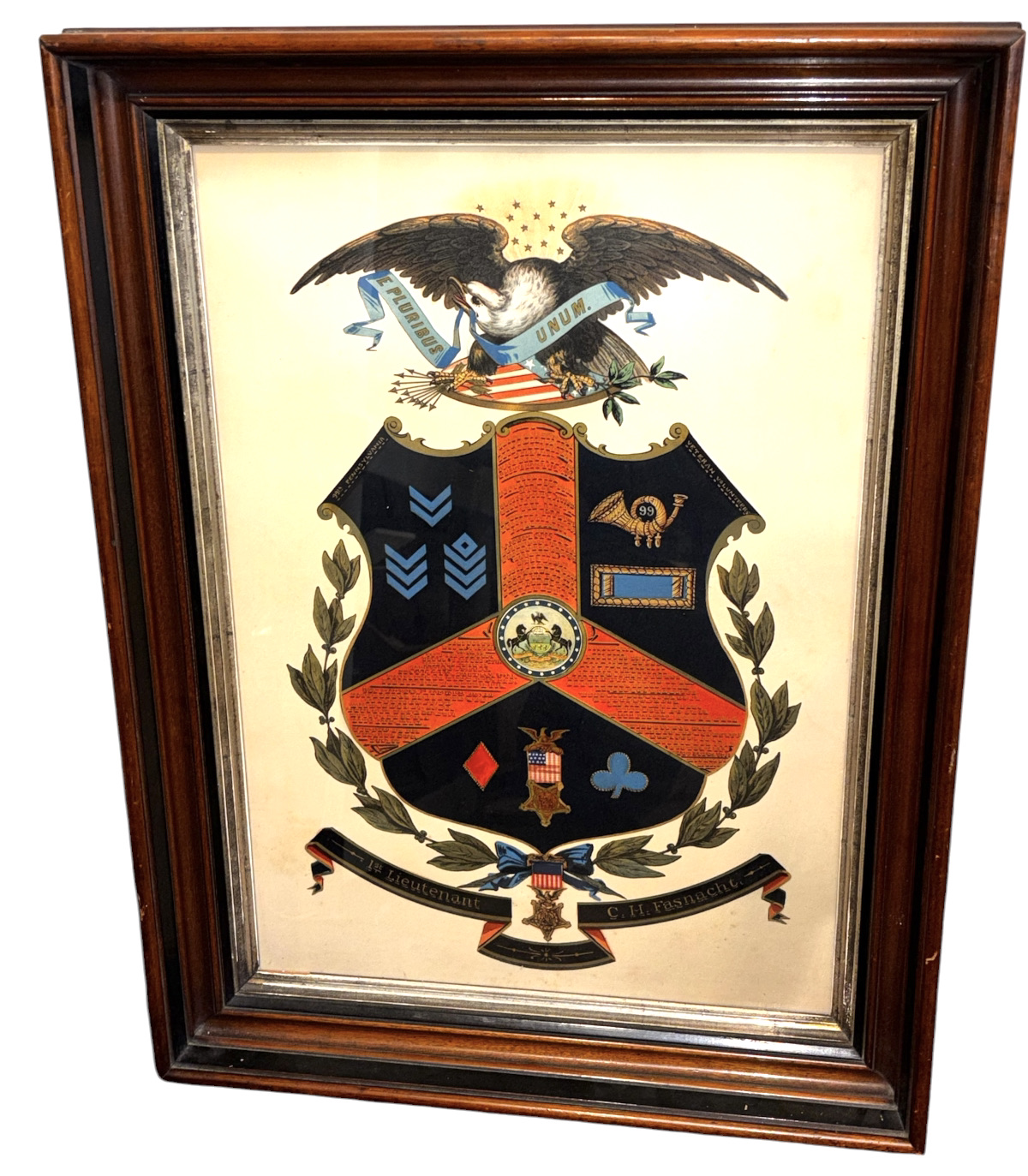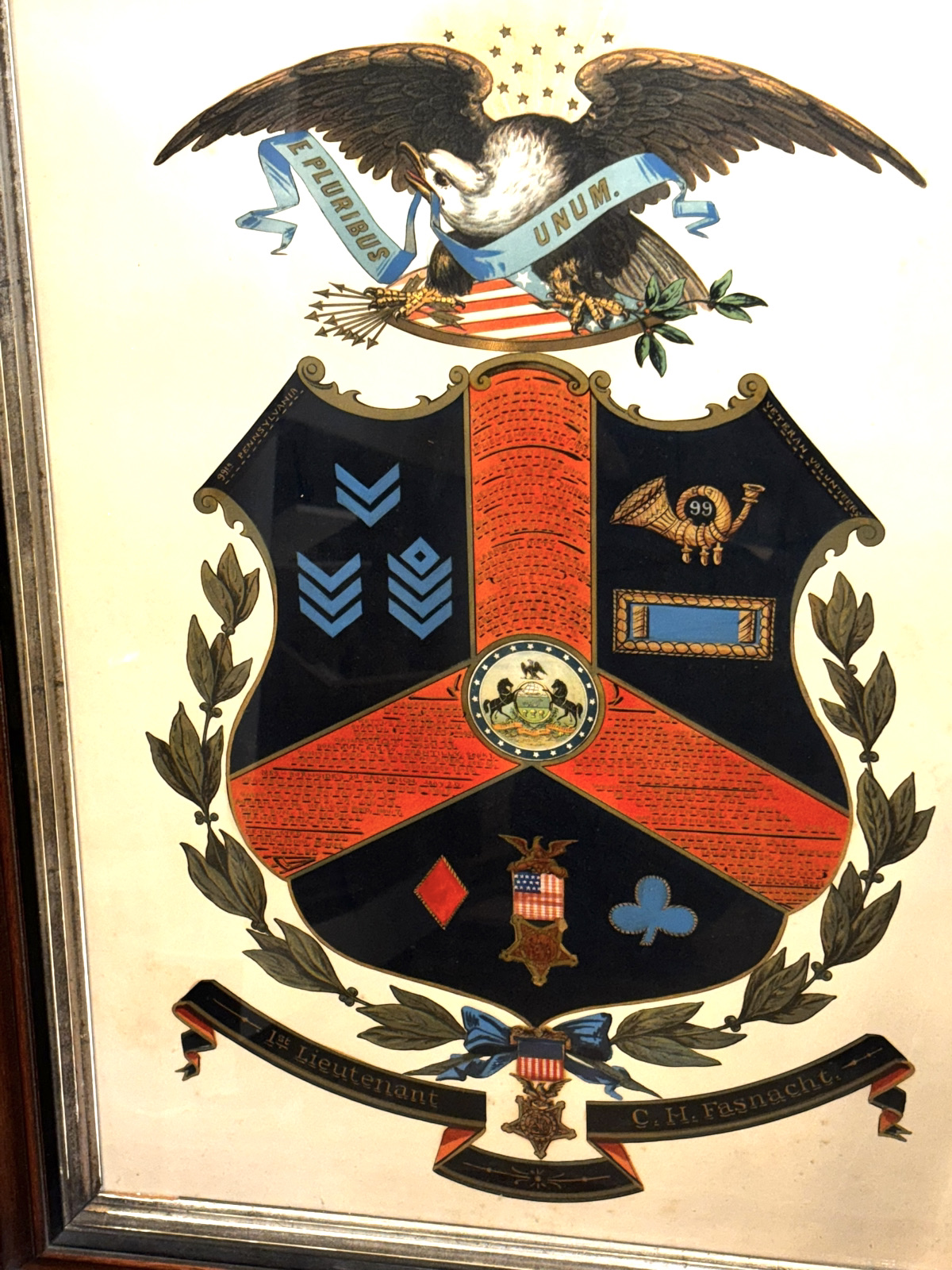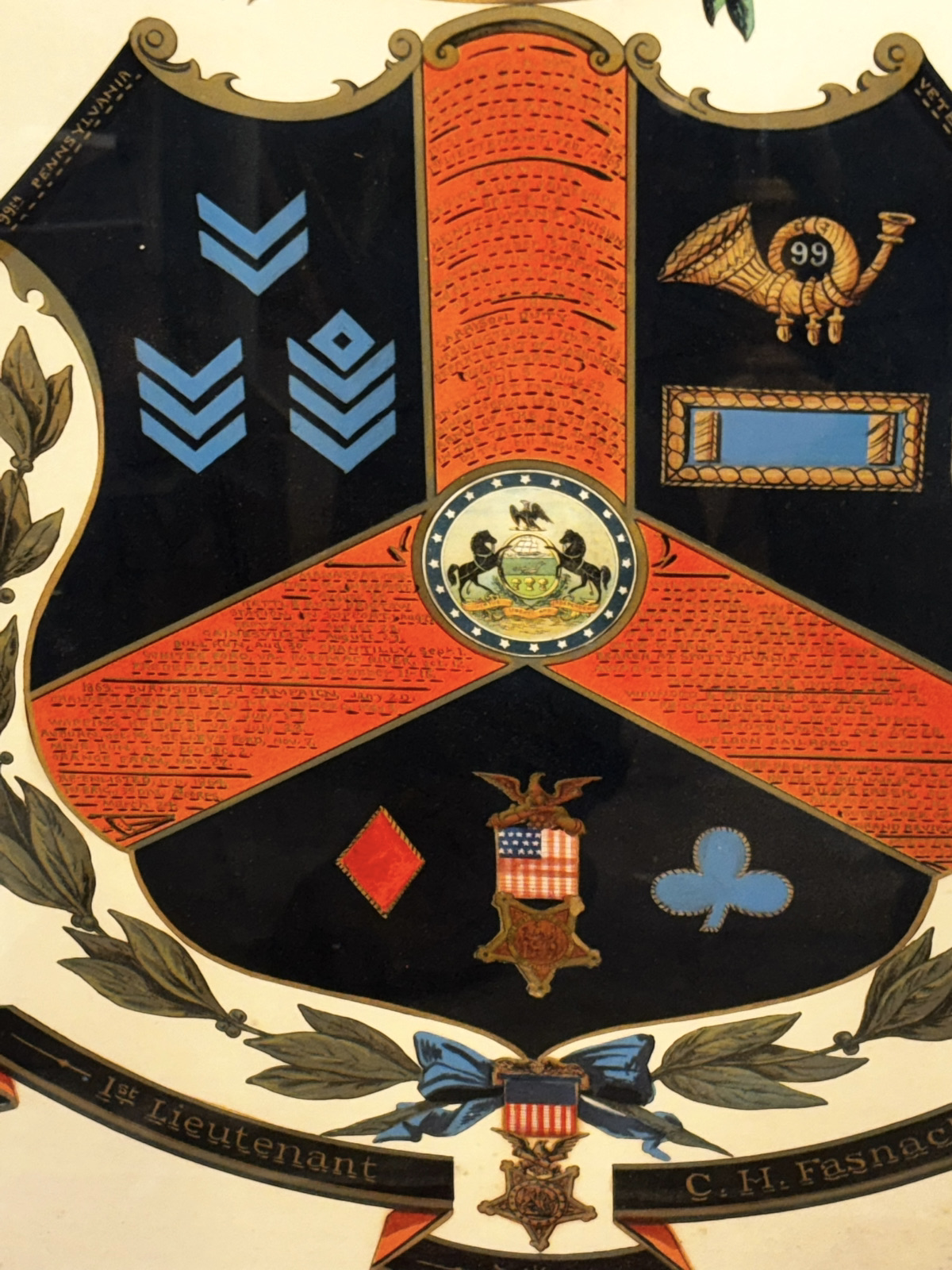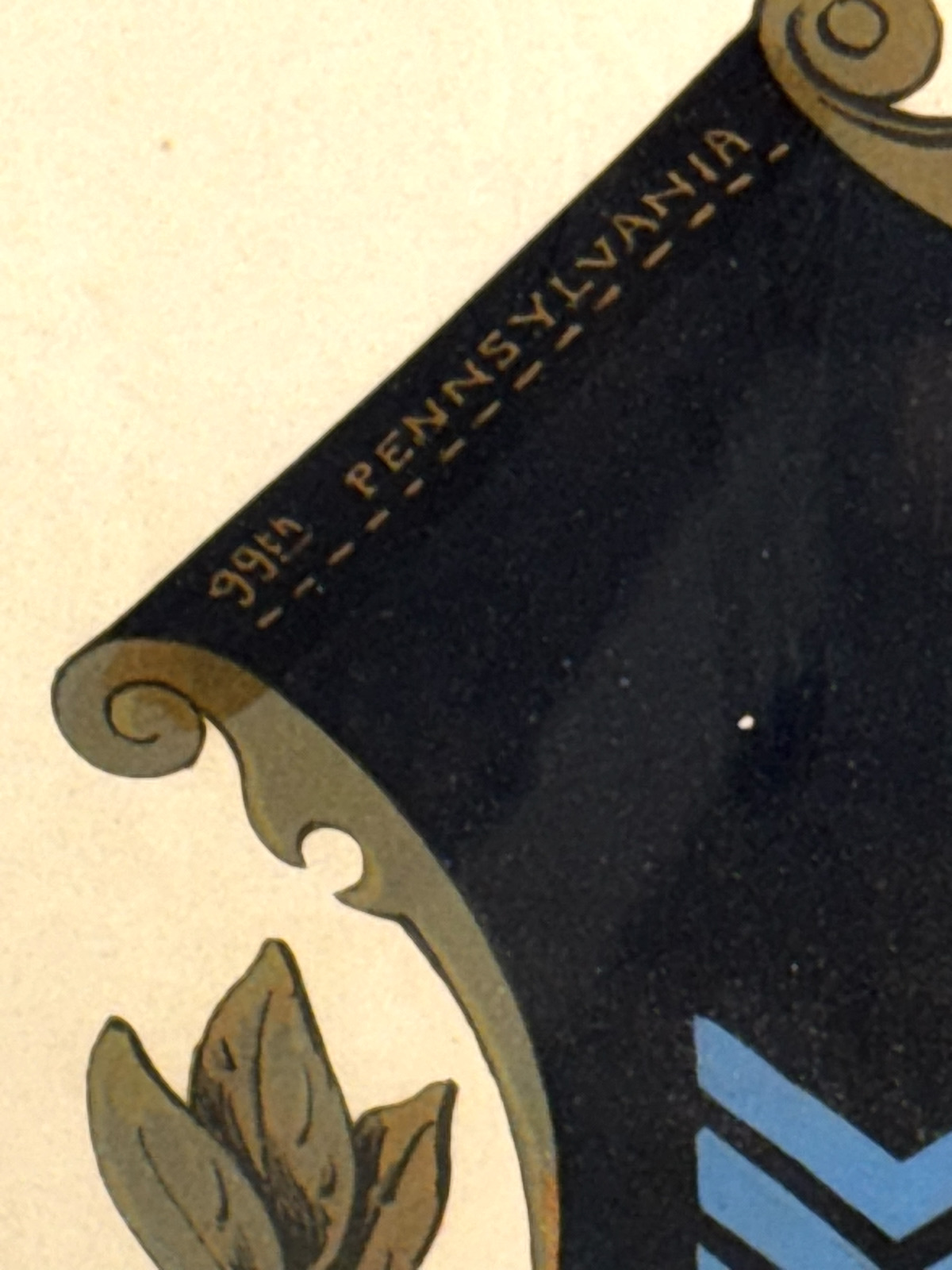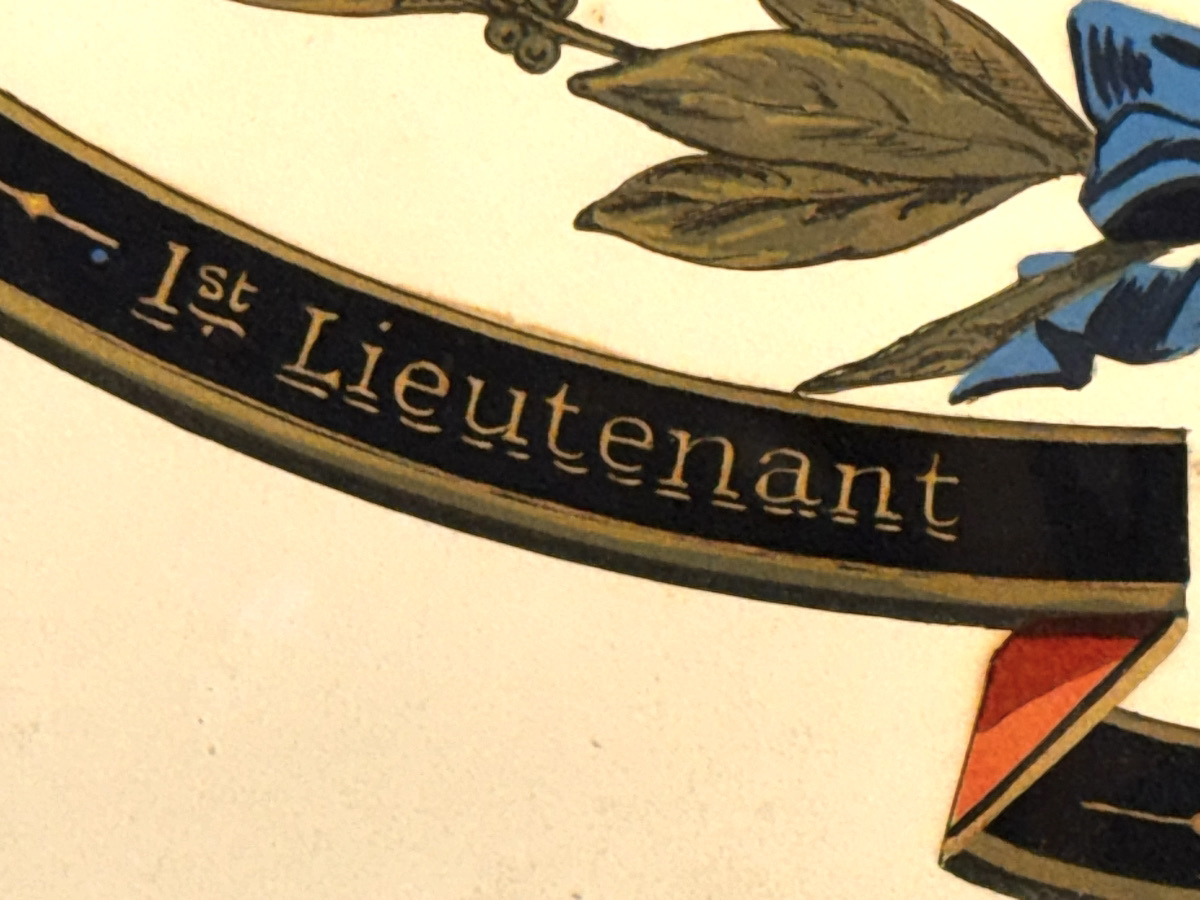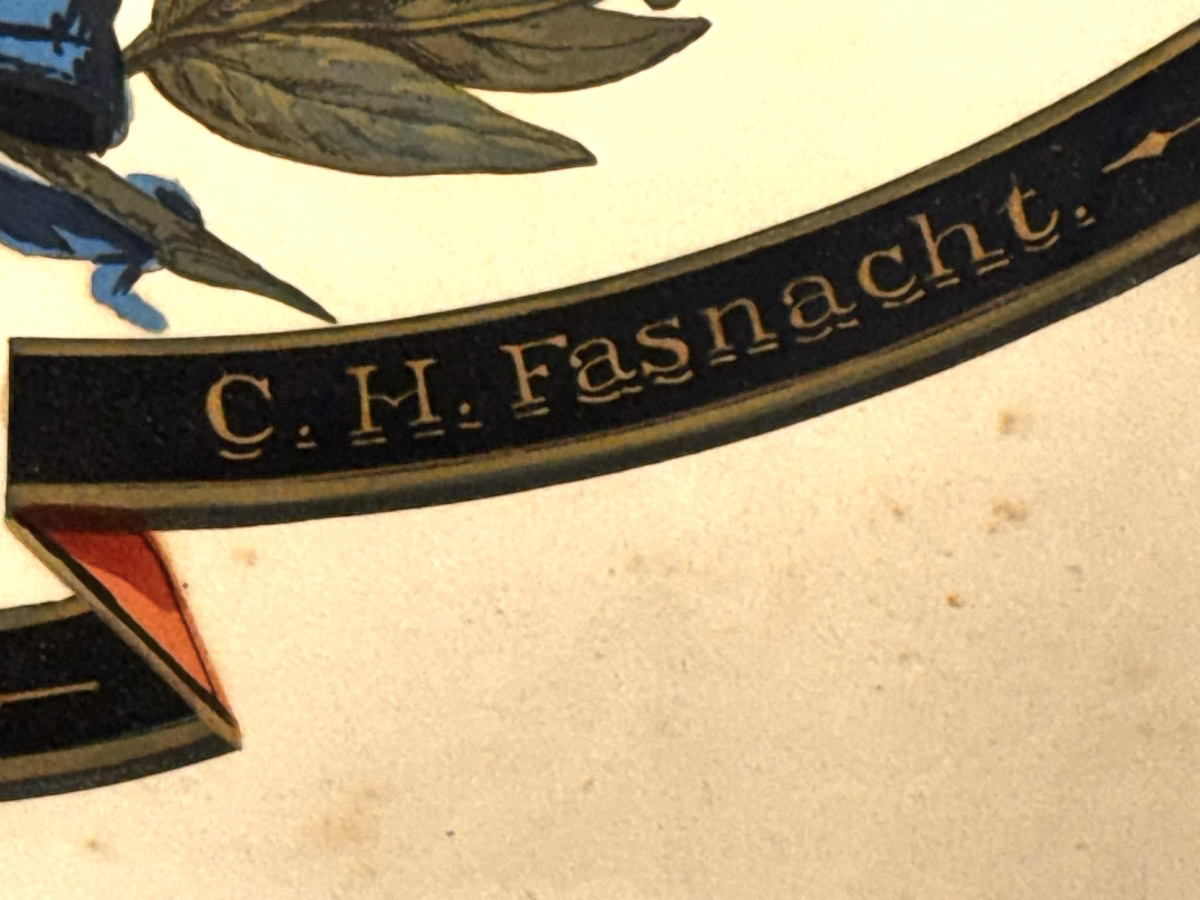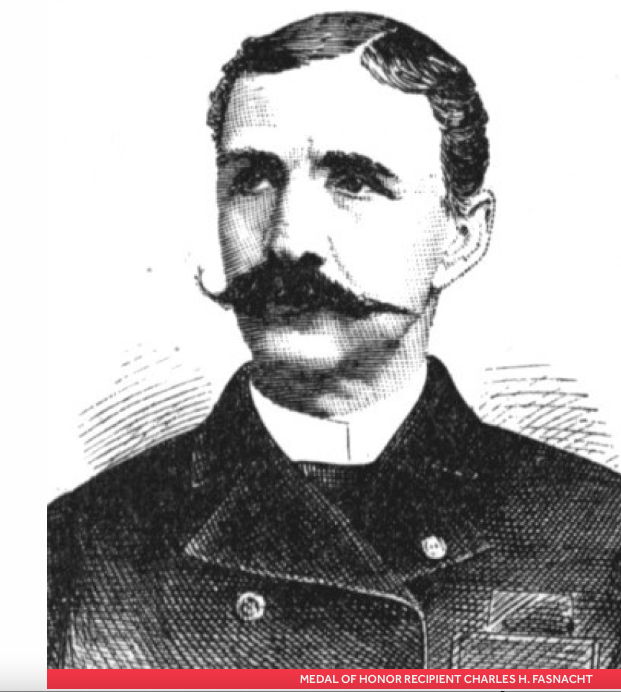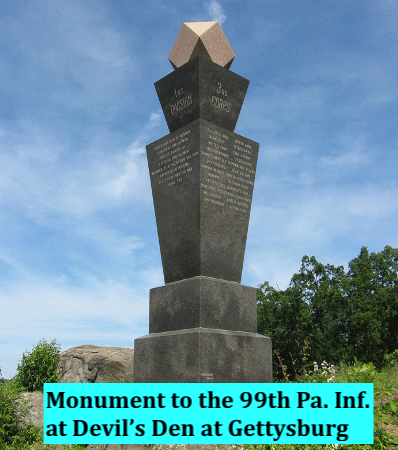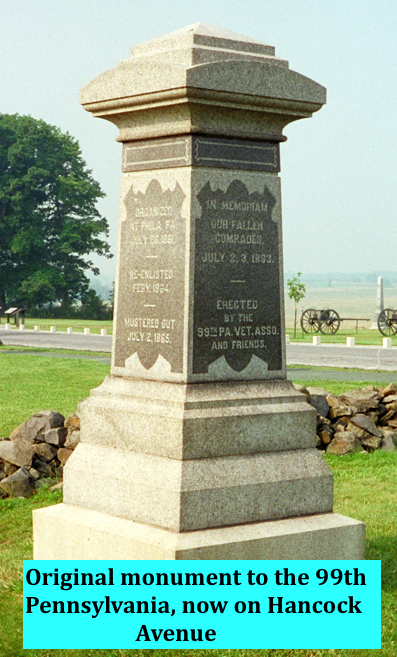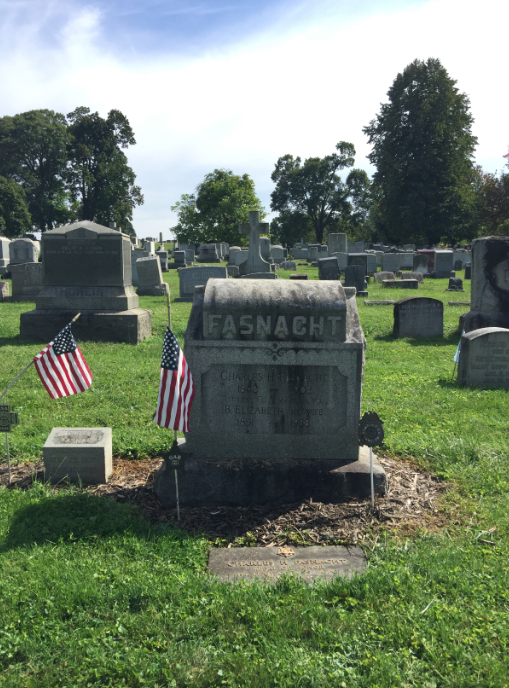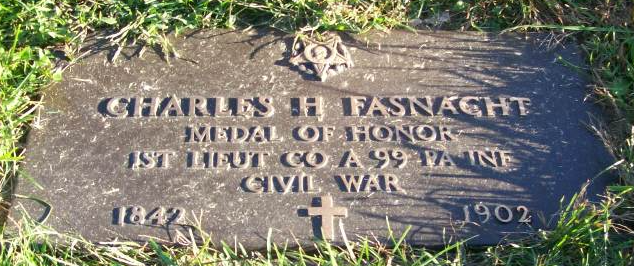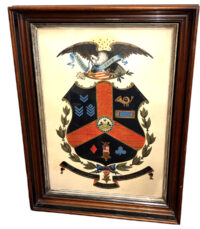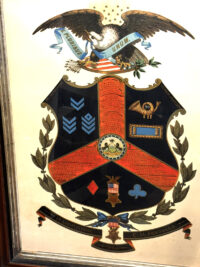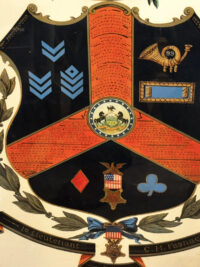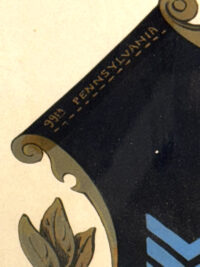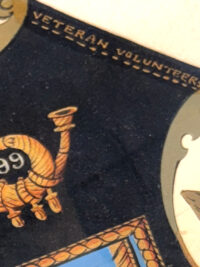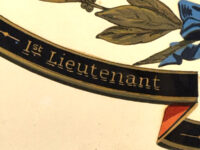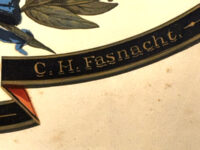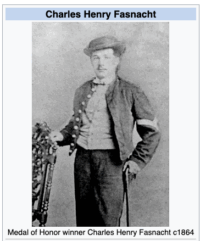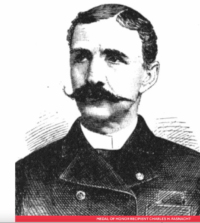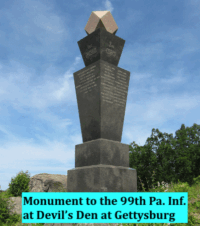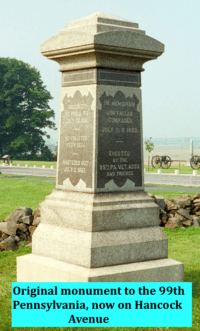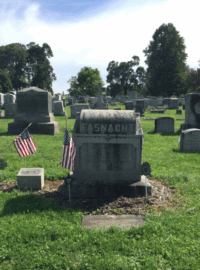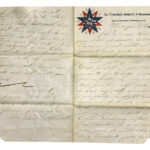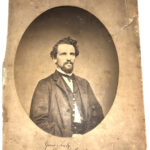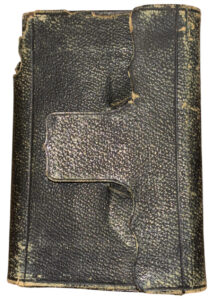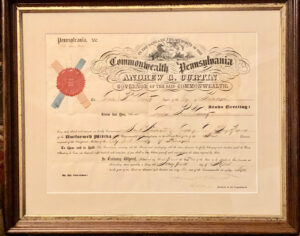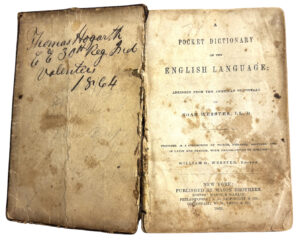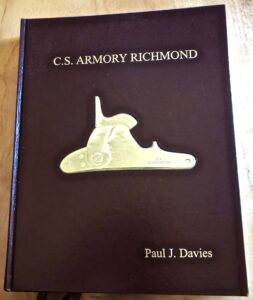Veteran’s Escutcheon in Original Frame – Lt. Charles H. Fasnacht – Medal of Honor Winner 99th Pa. Infantry
SOLD
Veteran’s Escutcheon in Original Frame – Lt. Charles H. Fasnacht – Medal of Honor Winner 99th Pa. Infantry – This escutcheon, of the several that we have had, is by far the most elaborately and decoratively styled, as well as the most significant. The escutcheon appears to be a hand-tinted, lithograph; it was completed in a most delicate and colorful manner; it represents the impressive service record of Charles Henry Fasnacht of Co. A 99th Pa. Infantry. Fasnacht enlisted in July 1861 into Co. A 99th Pa. Infantry, at the rank of Corporal; he would gradually be promoted to the ranks of Sergeant and 1st Sergeant and finally, in February 1865, to the rank of 1st Lieutenant. During his four years of service, Fasnacht would participate, with the 99th Pa., in most of the significant eastern theater engagements, to include: Bull Run, Fredericksburg, Chancellorsville, Gettysburg, Mine Run and Spotsylvania; during the course of this service, Fasnacht was wounded in action twice – first, at Fredericksburg, returning to active duty after recovering from this wound; at Spotsylvania, where Fasnacht would later be awarded the Medal of Honor for capturing the flag of the 2nd Louisiana Regiment (Louisiana Tigers) in a hand-to-hand “contest” on May 12, 1864, he was wounded again. During the course of the Battle of Spotsylvania, Sgt. Fasnacht fought and wrenched the 2nd Louisiana’s flag from its flag bearer but was soon wounded where he stood. After laying on the battlefield for a number of days, he was finally recovered by Confederate troops, destined to be sent to Richmond; fortuitously, before arriving in Richmond, he was rescued by Union troops; upon his repatriation, he revealed that he had hidden the captured Louisiana flag in his blouse while under guard by his Confederate captors. For his courageous efforts, Fasnacht was promoted to the rank of 1st Lt. in February 1865; several years after the war, he was awarded the Medal of Honor in April 1878.
Illuminated and illustrated on this escutcheon are depictions of the following:
- All of Charles Frasnacht’s ranks that he achieved during his service: Corporal, Sergeant, 1st Sergeant and 1st – all of the infantry
- An Officer’s Infantry hat badge with the number “99 “in the crook of the horn
- The state seal of Pennsylvania
- Two corps badges – 1st Division 3rd Corps, 3rd Division 2nd Corps
- GAR medal
- Civil War period Medal of Honor
Along the bottom of the decorative riband below the large blue shield, is painted: “1st Lieutenant / C. H. Frasnacht”. Along the top corners of the shield is painted: “99th Pennsylvania / Veteran Volunteers”. On the three red painted arms that intersect at the Pennsylvania state seal in the middle of the shield, are enumerated dates and locations of the various engagements, events in Frasnacht’s military service and promotions. The entire shield is surmounted by an American Eagle with “E Pluribus Unum” on the riband held in the beak of the eagle, with 13 stars above the eagle’s head and an American style flag shield behind the eagle’s talons. As mentioned, this is by far the most elaborately designed and illustrated escutcheon we have had.
The escutcheon remains in excellent condition, retaining vibrant color; it is contained within an original, period, walnut frame. The escutcheon has been archivally backed with acid free foam core.
Measurements: Frame – H: 28.25; W: 21“
Sight Size – H: 23 “W: 16 “
Charles H. Fasnacht
Residence Philadelphia, PA.
Enlisted on 7/26/1861 at Philadelphia, PA as a Corpl.
On 7/26/1861, he mustered into “A” Co. Pennsylvania 99th Infantry.
He was Mustered Out on 7/1/1865 at Washington, DC
He was listed as:
- Wounded 12/13/1862 Fredericksburg, VA
- Wounded 5/12/1864 Spotsylvania Court House, VA
Promotions:
- Sergt
- 1st Lieut 2/7/1865
Born 3/27/1842 in Lancaster County, PA
Member of GAR Post # 84 (George H. Thomas) in Lancaster, PA
Died 7/21/1902
Buried: Greenwood Cemetery, Lancaster, PA
Medal of Honor Information
He was awarded the Medal of Honor for action on 5/12/1864 at Spotsylvania Court House, VA.
(Capture of flag of 2nd LA Infantry in hand-to-hand contest)
| Name: | Charles H Fasnacht |
| Enlistment Age: | 19 |
| Birth Date: | 27 Mar 1842 |
| Birth Place: | Lancaster County, Pennsylvania, |
| Enlistment Date: | 26 Jul 1861 |
| Enlistment Place: | Philadelphia, Pennsylvania |
| Enlistment Rank: | Corporal |
| Muster Date: | 26 Jul 1861 |
| Muster Place: | Pennsylvania |
| Muster Company: | A |
| Muster Regiment: | 99th Infantry |
| Muster Regiment Type: | Infantry |
| Muster Information: | Enlisted |
| Rank Change Rank: | Sergt |
| Casualty Date: | 13 Dec 1862 |
| Casualty Place: | Fredericksburg, Virginia |
| Type of Casualty: | Wounded |
| Muster Out Date: | 1 Jul 1865 |
| Muster Out Place: | Washington, District of Columbia |
| Muster Out Information: | Mustered Out |
Civil War Medal of Honor Recipient. Born Karl Heinrich Fasnacht in Lancaster County, Pennsylvania, he was 19 years old when he mustered in as a Corporal in Company A, 99th Pennsylvania Volunteer Infantry. Promoted to Sergeant and wounded on the December 13, 1862 at Battle of Fredericksburg, he performed an act of bravery at the May 12, 1864 Battle of Spotsylvania that would see him awarded the Medal of Honor, with his citation reading “Capture of flag of 2nd Louisiana Tigers (C.S.A.) in a hand-to-hand contest”. During that bloody conflict he fought and wrenched the 2nd Louisiana’s flag from its flag bearer, but was soon wounded where he stood. After laying on the battlefield for a number of days, he was finally recovered by the Confederates, and sent to Richmond, Virginia. Before he got there he was rescued by Union troops, and it was revealed he had hid the captured Rebel flag in his blouse while under guard by the rebels. Promoted to 1st Lieutenant of Company A on February 7, 1865, he was honorably mustered out on July 1, 1865, and was awarded his Medal of Honor on April 2, 1878.
PENNSYLVANIA 99TH INFANTRY (Three Years) Ninety-ninth Infantry.-Cols., Thomas W. Sweeny, Peter Fritz, Jr., Asher S. Leidy, Edward R. Biles, Lieut.-Cols., William P. Seymour, Asher S. Leidy, Edward R. Biles, John W. Moore, Peter Fritz, Jr., Majs., Asher S. Leidy, Henry A. Read, John W. Moore, Peter Fritz, Jr., G. W. Tomlinson. The 99th regiment, composed of Philadelphia men, most of whom had served in the 22nd, was organized at Philadelphia and mustered into the U. S. service at different times from July, 1861, to Feb., 1862. The first three companies left for Washington on Aug. 8, 1861, and camped near Alexandria, where they were joined by the other companies as they arrived. On Feb. 19, 1862, the regiment was ordered to Washington for garrison duty at various forts, and in April, it was assigned to similar duty along the Anacosta river from Burning bridge to Alexandria. On July 4, at Harrison’s landing, it was assigned to the 2nd brigade, 1st division, 3rd corps, with which it had taken part in the campaign on the Peninsula and was active at the second Bull Run battle. It was engaged at Chantilly, but was not called into action at Antietam, being next closely engaged at the battle of Fredericksburg. In May, 1863, at Chancellorsville, the regiment shared in the famous charge made by Gen. Kearny. It remained in this vicinity until the opening of the Gettysburg campaign. On July 2, the regiment was hotly engaged, but held its ground with great loss of numbers until relieved. For its heroism it was highly complimented and thanked by Gen. Ward and Gen. Birney. Moving southward with the army, the 99th went into camp near the Warrenton sulphur springs, where it was stationed until Oct. 10. On Nov. 7, it captured a large body of prisoners at Kelly’s ford on the Rappahannock where it was sent to clear the way for the troops. It participated in the Mine Run campaign, then established winter quarters at Brandy Station where in Feb., 1864, a large number of the regiment reenlisted and were furloughed. On April 7, they returned to Brandy Station, when the Army of the Potomac was reorganized, the 99th forming part of the 1st brigade, 3rd division, 2nd corps, which left Brandy Station on May 3, and was called into action at the Wilderness. It held its ground during the night of May 5, and advanced the next day, displaying great bravery, holding its position until all the other troops except the 20th Indiana had been forced back. It was thanked for its heroism by Gen. Birney. At Spottsylvania it participated in the gallant charge of the 2nd corps, capturing 2 battleflags and 2 pieces of artillery, besides its share of the prisoners. Another successful assault was made by the 99th Pa. and the 20th Ind. on the 17th, and on the 29th the regiment received the veterans and recruits from the 26th Pa. Moving to Petersburg it was engaged at Deep Bottom in July, capturing a battery and on its return to Petersburg the troops were complimented by Gen. Hancock in special orders. Again, for gallantry in capturing a picket line on Sept. 10, the 99th was mentioned in special orders by Hancock. Early in October it had several skirmishes with the enemy about Poplar Grove Church and a few days later met the enemy on the Boydton plank road. It took part in the raid on the Weldon railroad, going into winter quarters at Fort Seibert near the Vaughan road, along which it spent considerable time on picket duty. It engaged at Hatcher’s run in Feb., 1865, and near the Davis house in March. Advancing with the army it was active at Sailor’s creek and at Appomattox Court House, where it received the welcome news of Lee’s surrender. Returning to Richmond and then Washington it took part in the grand review of the Union armies, and was mustered out on July 1, 1865.
| Charles Henry Fasnacht | |
| Medal of Honor winner Charles Henry Fasnacht c1864 | |
| Born | March 27, 1842 Lancaster County, Pennsylvania |
| Died | July 21, 1902 (aged 60) |
| Buried | Greenwood Cemetery |
| Allegiance | United States of America |
| Service / branch | United States Army Union Army |
| Rank | Sergeant |
| Unit | Company A, 99th Pennsylvania Infantry |
| Battles / wars | Battle of Spotsylvania Court House Battle of Fredericksburg |
| Awards | Medal of Honor |
Sergeant Charles Henry Fasnacht (born Karl Heinrich Fasnacht; March 27, 1842 – July 21, 1902) was an American soldier who fought in the American Civil War. Fasnacht received the country’s highest award for bravery during combat, the Medal of Honor, for his action during the Battle of Spotsylvania Court House in Virginia on 12 May 1864. He was honored with the award on 2 April 1878.
Biography
Fasnacht was born in Lancaster County, Pennsylvania on 27 March 1842.
After the start of the Civil War, Fasnacht enlisted in the 99th Pennsylvania Infantry. After performing the act of gallantry earned him the Medal of Honor on 12 May 1864 during the Battle of Spotsylvania Court House, he was captured by the Confederates, after being wounded on the battlefield. Having hid the captured flag under his shirt, he was later rescued by Union troops while being transferred to Richmond, Virginia. Fasnacht continued to fight in the war until he was mustered out on 1 July 1865.
He died on 21 July 1902 and his remains are interred at the Greenwood Cemetery in Pennsylvania.
Medal of Honor citation
The President of the United States of America, in the name of Congress, takes pleasure in presenting the Medal of Honor to Sergeant Charles H. Fasnacht, United States Army, for extraordinary heroism on 12 May 1864, while serving with Company A, 99th Pennsylvania Infantry, in action at Spotsylvania, Virginia, for capture of flag of 2d Louisiana Tigers (Confederate States of America) in a hand-to-hand contest.
The second ceremony honored Charles H. Fasnacht, who served in Company A, 99th Pennsylvania Infantry during the Civil War. He was cited for capturing the flag of the 2nd Louisiana Regiment (Louisiana Tigers) in a hand-to-hand contest on May 12, 1864. He received his Medal of Honor on April 2, 1878. Sergeant Fasnacht (later First Lieutenant) is buried in Greenwood Cemetery in Lancaster. Scott Fasnacht and his brother James, great-grandsons of Charles Fasnacht, took part in the wreath laying ceremony.
Inscription on the Headstone of Lt. Fasnacht
“MEDAL OF HONOR
1ST LIEUT CO A 99 PA INF
CIVIL WAR”
Service
The 99th Pennsylvania Infantry was organized at Philadelphia, Pennsylvania July 26, 1861, through January 18, 1862, as the 32nd Pennsylvania Infantry (not to be confused with the 3rd Pennsylvania Reserves/32nd Pennsylvania Infantry). Three companies moved to Washington, DC on August 8, 1861, and the regiment was eventually mustered in for a three-year enlistment under the command of Colonel Thomas Sweeney. The regimental designation was officially changed in February 1862.
The regiment was attached to Defenses of Washington, D.C., to October 1861. Jameson’s Brigade, Heintzelman’s Division, Army of the Potomac, to February 1862. Military District of Washington to June 1862. 3rd Brigade, 3rd Division, III Corps, Army of the Potomac, to August 1863. 3rd Brigade, 1st Division, III Corps, to December 1862. 2nd Brigade, 1st Division, III Corps, to August 1868. 3rd Brigade, 1st Division, III Corps, to October 1863. 2nd Brigade, 1st Division, III Corps, to March 1864. 1st Brigade, 3rd Division, II Corps, to July 1865.
The 99th Pennsylvania Infantry mustered out July 1, 1865.
Detailed service
Duty in the defenses of Washington, D.C., until June 29, 1862. Moved to Harrison’s Landing June 29-July 4, and duty there until August 16. Movement to Fortress Monroe, then to Centreville August 16–26. Pope’s Campaign in northern Virginia August 26-September 2. Battle of Groveton August 29. Second Battle of Bull Run August 30. Battle of Chantilly September 1. Duty in the Defenses of Washington, D.C., and outpost picket duty until October. White’s Ford, Md., October 12. Movement up the Potomac to Leesburg, then to Falmouth, Va., October 11-November 19. Battle of Fredericksburg December 12–15. Burnside’s 2nd Campaign, “Mud March,” January 20–24, 1863. At Falmouth until April. Chancellorsville Campaign April 27-May 6. Battle of Chancellorsville May 1–5. Gettysburg Campaign June 11-July 24. Battle of Gettysburg July 1–3.
This is Pennsylvania, and our home. —99th Pennsylvania’s battle cry, witnessed by Corporal Peter Ears, Co. E, during the 99th Pennsylvania’s bayonet charge at Devil’s Den, Gettysburg, July 2, 1863.
Pursuit of Lee July 5–24. Wapping Heights, Va., July 23. Duty on line of the Rappahannock until October. Bristoe Campaign October 9–22. Auburn October 13. Advance to line of the Rappahannock November 7–8. Kelly’s Ford November 7. Mine Run Campaign November 26-December 2. Payne’s Farm November 27. Demonstration on the Rapidan February 6–7, 1864. Duty near Brandy Station until May. Rapidan Campaign May 4-June 12. Battles of the Wilderness May 5–7. Laurel Hill May 8. Spotsylvania May 8–12. Po River May 10. Spotsylvania Court House May 12–21. Assault on the Salient May 12. Harris Farm, Fredericksburg Road May 19. North Anna River May 23–26. On line of the Pamunkey May 26–28. Totopotomoy May 28–31. Cold Harbor June 1–12. Before Petersburg June 16–18. Siege of Petersburg June 16, 1864, to April 2, 1865. Jerusalem Plank Road June 21–23, 1864. Demonstration on north side of the James at Deep Bottom July 27–29. Deep Bottom July 27–28. Mine Explosion, Petersburg, July 30 (reserve). Demonstration on north side of the James River at Deep Bottom August 13–18. Strawberry Plains, Deep Bottom, August 14–18. Poplar Springs Church September 29-October 2. Boydton Plank Road, Hatcher’s Run, October 27–28. Raid on Weldon Railroad December 7–12. Dabney’s Mills, Hatcher’s Run, February 5–7, 1865. Watkins’ House, Petersburg, March 25. Appomattox Campaign March 28-April 9. Crow’s House March 31. Fall of Petersburg April 2. Sailor’s Creek April 6. High Bridge, Farmville, April 7. Appomattox Court House April 9. Surrender of Lee and his army. At Burkesville until May 2. March to Washington, D.C., May 2–12. Grand Review of the Armies May 23.
Casualties
The regiment lost a total of 235 men during service; 9 officers and 113 enlisted men killed or mortally wounded, 1 officer and 112 enlisted men died of disease.
Commanders
- Colonel Thomas Sweeney – resigned January 24, 1862
- Colonel Peter Fritz, Sr. – resigned June 10, 1862
- Colonel Asher S. Leidy
- Colonel Edwin Ruthwin Biles
- MajorJohn W. Moore – commanded at the Battle of Gettysburg until wounded in action
- CaptainPeter Fritz, Jr. – commanded at the Battle of Gettysburg after Maj Moore was wounded and returned to command on July 3
Notable members
- 1st LieutenantSylvester Bonnaffon, Jr., Company G – Medal of Honor recipient for action at the Battle of Boydton Plank Road
- SergeantCharles H. Fasnacht, Company A – Medal of Honor recipient for action at the Battle of Spotsylvania Court House
- Sergeant Albert Magnin, Company C – Pennsylvania State Representative for Delaware County, 1889-1892
- Sergeant Harvey M. Munsell, Company A – Medal of Honor recipient for action at the Battle of Gettysburg, July 1–3; color sergeant who carried the regiment’s colors through 13 battles
99th Regiment, Pennsylvania Infantry
Overview:
Organized at Philadelphia as 32nd Pennsylvania Volunteers July 26, 1861, to January 18, 1862. Three Companies moved to Washington, D. C., August 8, 1861. Attached to Defences of Washington, D. C., to October, 1861. Jameson’s Brigade, Heintzelman’s Division, Army Potomac, to February, 1862. Military District of Washington to June, 1862. 3rd Brigade, 3rd Division, 3rd Army Corps, Army Potomac, to August, 1863. 3rd Brigade, 1st Division, 3rd Army Corps, to December, 1862. 2nd Brigade, 1st Division, 3rd Army Corps, to August, 1863. 3rd Brigade, 1st Division, 3rd Army Corps, to October, 1863. 2nd Brigade, 1st Division, 3rd Army Corps, to March, 1864. 1st Brigade, 3rd Division, 2nd Army Corps, to July, 1865.
Service:
Duty in the Defences of Washington, D. C., till June 29, 1862. Moved to Harrison’s Landing June 29-July 4, and duty there till August 16. Movement to Fortress Monroe, thence to Centreville August 16-26. Pope’s Campaign in Northern Virginia August 26-September 2. Battles of Groveton August 29; Bull Run August 30; Chantilly September 1. Duty in the Defences of Washington, D. C., and outpost picket duty till October. White’s Ford, Md., October 12. Movement up the Potomac to Leesburg, thence to Falmouth, Va., October 11-November 19. Battle of Fredericksburg December 12-15. Burnside’s 2nd Campaign, “Mud March,” January 20-24, 1863. At Falmouth till April. Chancellorsville Campaign April 27-May 6. Battle of Chancellorsville May 1-5. Gettysburg (Pa.) Campaign June 11-July 24. Battle of Gettysburg, Pa., July 1-3. Pursuit of Lee July 5-24. Wapping Heights, Va., July 23. Duty on line of the Rappahannock till October. Bristoe Campaign October 9-22. Auburn October 13. Advance to line of the Rappahannock November 7-8. Kelly’s Ford November 7. Mine Run Campaign November 26-December 2. Payne’s Farm November 27. Demonstration on the Rapidan February 6-7, 1864. Duty near Brandy Station till May. Rapidan Campaign May 4-June 12. Battles of the Wilderness May 5-7; Laurel Hill May 8; Spottsylvania May 8-12; Po River May 10; Spottsylvania C. H. May 12-21. Assault on the Salient May 12. Harris Farm, Fredericksburg Road May 19. North Anna River May 23-26. On line of the Pamunkey May 26-28. Totopotomoy May 28-31. Cold Harbor June 1-12. Before Petersburg June 16-18. Siege of Petersburg June 16, 1864, to April 2, 1865. Jerusalem Plank Road June 21-23, 1864. Demonstration on north side of the James at Deep Bottom July 27-29. Deep Bottom July 27-28. Mine Explosion, Petersburg, July 30 (Reserve). Demonstration on north side of the James at Deep Bottom August 13-18. Strawberry Plains, Deep Bottom, August 14-18. Poplar Springs Church September 29-October 2. Boydton Plank Road, Hatcher’s Run, October 27-28. Raid on Weldon Railroad December 7-12. Dabney’s Mills, Hatcher’s Run, February 5-7, 1865. Watkins’ House, Petersburg, March 25. Appomattox Campaign March 28-April 9. Crow’s House March 31. Fall of Petersburg April 2. Sailor’s Creek April 6. High Bridge, Farmville, April 7. Appomattox C. H. April 9. Surrender of Lee and his army. At Burkesville till May 2. March to Washington. D. C., May 2-12. Grand Review May 23. Mustered out July 1, 1865.
Regiment lost during service 9 Officers and 113 Enlisted men killed and mortally wounded and 1 Officer and 112 Enlisted men by disease. Total 235.
99th Pennsylvania Volunteer Infantry Regiment at Gettysburg
There are two monuments to the 99th Pennsylvania Volunteer Infantry Regiment on the Gettysburg battlefield. The original monument was first located at the Devil’s Den, and was moved to along Hancock Avenue. The new monument replaced the original monument at the Devil’s Den location and was dedicated in 1889. )
The 99th Pennsylvania was commanded at the Battle of Gettysburg by Major John W. Moore. It brought 339 men to the field
The Battle of Gettysburg
Main monument to the 99th Pennsylvania Infantry is at the Devil’s Den
The startlingly modern design of the monument incorporates among its abstract shapes both the diamond symbol of the 3rd Army Corps and the keystone symbol of Pennsylvania.
From the front of the monument at the Devil’s Den:
99th Pennsylvania Infantry
Fought on this line in the afternoon of July 2nd.
Present at Gettysburg 339 Officers and men.
Killed and died of wounds 1 officer and 24 men.
Wounded 4 officers and 70 men.
Captured or missing 11 men.
Total 110
From the left side of the monument:
2nd Brigade
Recruited in Phila and Lancaster Counties.
Mustered in July 21 1861 to January 18 1862.
Re-enlisted January 1864,
Mustered out July 1 1865.
Total enrollment 2140
From the rear of the monument:
1st Division
Killed and died of wounds 9 officers and 115 men
Died of disease & c 1 officer and 116 men
Wounded 27 officers and 337 men
Captured or missing 2 officers and 153 men
Total 760
From the right side of the monument:
3rd Corps
2nd Bull Run North Anna
Chantilly Totopotomy
White’s Ford Cold Harbor
Fredericksburg Petersburg
Chancellorsville Strawberry Plains
Gettysburg Deep Bottom
Wapping Heights Poplar Springs
Auburn Boydton Road
Kelly’s Ford Hatcher’s Run
Mine Run Petersburg Watkins’ House
Wilderness Amelia Springs
Spotsylvania Appomattox
Location of the main monument to the 99th Pennsylvania at Gettysburg
The main monument to the 99th Pennsylvania is south of Gettysburg about 40 yards east of Sickles Avenue as it leaves the Devil’s Den area. (39°47’32.5″N 77°14’32.2″W)
Original monument to the 99th Pennsylvania Infantry at Gettysburg
The original monument to the 99th Pennsylvania is now on Hancock Avenue. (Hancock Avenue Pt. 3 tour map) It was originally erected at the Devil’s Den and dedicated in 1886 by the regimental veterans association. When the state made funding available for Pennsylvania regimental monuments in 1889 it was decided to create a new monument on the Devil’s Den location, and the original monument was moved to the regiment’s secondary position on Hancock Avenue.
The original monument to the 99th Pennsylvania, now on Hancock Avenue
From the front of the Hancock Avenue monument:
99th Regt. Pa. Vols.
Army of the Potomac
From Sept. 1861 to July 1865.
2nd Brigade 1st Division 3rd Corps

